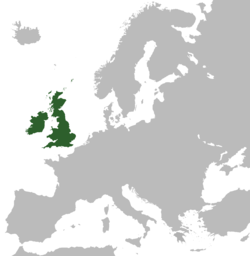
Back پروتکتورا دؤنمی AZB Протекторат (Англия) Bulgarian প্রটেক্টরেট Bengali/Bangla El Protectorat Catalan Británie v době protektorátu Czech Προτεκτοράτο (Μεγάλη Βρετανία, Ιρλανδία) Greek Angla Protektorato Esperanto El Protectorado Spanish Protectorate French Protektoraat (Britske Eilannen) Frisian
Commonwealth of England, Scotland and Ireland | |||||||||||
|---|---|---|---|---|---|---|---|---|---|---|---|
| 1653–1659 | |||||||||||
| Motto: Pax quaeritur bello ("Peace is obtained through war") | |||||||||||
 The territory of the Commonwealth in 1659 | |||||||||||
| Capital | London | ||||||||||
| Common languages | English (official) Scots, Irish, Welsh, Cornish, Scottish Gaelic, Norn, Yola, Fingallian | ||||||||||
| Religion | Protestantism | ||||||||||
| Government | Unitary parliamentary republic with an executive presidency under a military dictatorship | ||||||||||
| Lord Protector | |||||||||||
• 1653–1658 | Oliver Cromwell | ||||||||||
• 1658–1659 | Richard Cromwell | ||||||||||
| Legislature | Parliament | ||||||||||
| Other House (1658–59) | |||||||||||
| House of Commons (1654–55/1656–58/1659) | |||||||||||
| History | |||||||||||
| 16 December 1653 | |||||||||||
| 12 April 1654 | |||||||||||
| 25 May 1657 | |||||||||||
• R. Cromwell's resignation | 25 May 1659 | ||||||||||
| Currency | Pound sterling (England) Pound Scots (Scotland) Irish pound (Ireland) | ||||||||||
| |||||||||||
| Today part of | Republic of Ireland United Kingdom | ||||||||||
The Protectorate, officially the Commonwealth of England, Scotland and Ireland, was the English form of government lasting from 16 December 1653 to 25 May 1659, under which the kingdoms of England, Scotland, and Ireland, with their associated territories were joined together in the Commonwealth of England, governed by a Lord Protector. It began when Barebone's Parliament was dissolved, and the Instrument of Government appointed Oliver Cromwell as Lord Protector of the Commonwealth. Cromwell died in September 1658 and was succeeded by his son Richard Cromwell.
Richard resigned in May 1659 due to his inability to control either the Army or Parliament. He was replaced by the English Committee of Safety, which dissolved the Third Protectorate Parliament, and reseated the Rump Parliament dismissed by his father in April 1653. This marked the end of the Protectorate, with the Rump acting as the legislature and the English Council of State as the executive.


